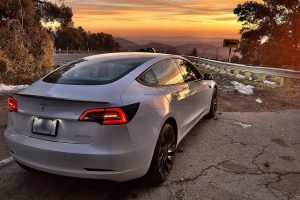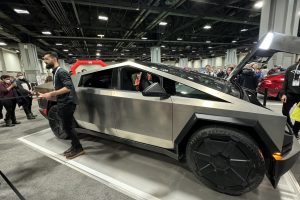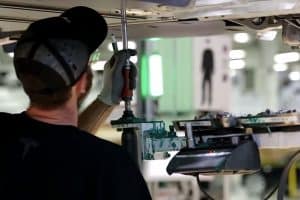- 🚗 Tesla’s $25,000 EV is viewed as crucial by analysts for capturing a larger market share.
- 🤖 Tesla’s Robotaxi event lacked sufficient details, and clarity is needed on performance metrics.
- 🚙 The profitability of Tesla’s Cybertruck remains a concern as it is still early in production stages.
- 🏛️ Future EV policies under potential Trump or Harris presidencies may impact Tesla’s strategy.
In recent years, Tesla has become synonymous with innovation in the electric vehicle (EV) sector. With a visionary like Elon Musk at the helm, the company continues to push the boundaries of what’s possible in transportation. The latest discussions about Tesla’s $25,000 EV, the details surrounding its Robotaxi service, the challenges with the Cybertruck, and the potential impacts of future U.S. presidential policies highlight the strategic maneuvers Tesla may undertake to sustain its market dominance and drive innovation further. In this blog post, we dissect these key topics, offering insights and potential implications for Tesla and the broader automotive industry.
Tesla’s $25,000 EV: The Game-Changer
Market Impact
The announcement of a $25,000 Tesla EV has electrified industry experts and consumers alike. Analysts view this as a pivotal step for Tesla to infiltrate and capture a more significant market share, particularly in the affordable vehicle segment.
- Affordability and Accessibility: A lower-priced EV makes sustainable transportation accessible to a broader audience. This could significantly increase Tesla’s customer base, attracting new demographics who previously found Tesla vehicles financially out of reach.
- Competitive Edge: Priced within reach of models like the Toyota Corolla, the $25,000 Tesla is set to challenge traditional internal combustion engine vehicles, potentially enticing buyers to switch to electric.
Implementation Strategy
Tesla must consider several factors to ensure the successful launch and sustained sales of this model:
- Supply Chain Management: The challenge of producing a cheaper EV without compromising on quality requires robust supply chain strategies.
- Production Efficiency: To maintain profitability, Tesla will need to scale production efficiently, likely leveraging advancements in its gigafactories.
- Incentives and Government Policies: Incentives from governments globally will be critical in lowering entry barriers for potential EV buyers.
Robotaxi Clarification: Bridging the Information Gap
The Robotaxi initiative is another bold step that positions Tesla at the forefront of autonomous driving technology. However, the recent event left several questions unanswered, sparking concerns about Tesla’s readiness for widespread implementation.
Regulatory Hurdles
Tesla must address the key regulatory challenges to move forward with its Robotaxi service:
- Performance Metrics: Specifically, Tesla will need to demonstrate significant improvements, like reducing disengagements per mile to meet regulatory standards.
- Safety Assurances: Regulatory bodies will require comprehensive safety assurances before autonomous vehicles are allowed on public roads without a driver.
Technological Advancements
Securing a successful rollout will require:
- Data Utilization: Leveraging data from the extensive fleet to train and refine AI models, improving reliability and safety.
- Collaborative Efforts: Partnering with technology companies and regulatory bodies can facilitate smoother transitions in regulatory approval processes.
Cybertruck Profitability Challenges
The Tesla Cybertruck, with its futuristic design and promising performance, faces scrutiny regarding its profitability as it advances into the production phase.
Cost Management
Managing production costs will be key to the Cybertruck’s success:
- Materials and Manufacturing: Implementing cost-effective material sourcing and manufacturing processes will be crucial to balance initial expenditure and revenue.
- Demand Forecasting: Accurately projecting consumer demand to align production and avoid overproduction or shortages.
Production Milestones
Tesla aims to reach breakeven profitability soon, but several hurdles remain:
- Scaling Production: Efficiently ramping up production capabilities to meet preorder demand while ensuring quality.
- Market Reception: Continuously assessing market feedback for adjustments in production or marketing strategies.
Political Impacts on Tesla’s Strategy
The upcoming U.S. presidential election poses potential shifts in EV policies under possible Trump or Harris administrations, which could influence Tesla’s strategic direction.
Economic Policies
- Trump Administration: Tesla might look towards a continuation of more business-friendly policies and less emphasis on stringent EV mandates.
- Harris Administration: Could see an increased focus on EV mandates and incentives, potentially benefitting Tesla’s growth in the sustainable transportation sector.
Strategic Adaptability
Tesla must remain agile:
- Proactive Lobbying: Engaging continuously with policymakers to advocate for favorable conditions for the EV industry.
- Diversified Markets: Maintaining and expanding international markets to hedge against potential domestic policy shifts.
Conclusion
Tesla’s journey towards democratizing access to electric vehicles through its upcoming $25,000 model, advancing autonomous driving with Robotaxis, navigating Cybertruck production challenges, and adapting to political landscapes demonstrates its relentless pursuit of innovation. The strategic choices Tesla makes today will dictate its future market position, altering not just the company’s trajectory but potentially redefining automotive and transportation norms worldwide.





